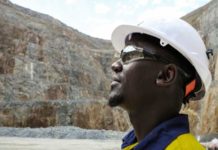
[miningmx.com] – THE coast is clear for Atlatsa Resources to produce a much improved second half to its financial year by dint of two factors: 36,000 ounces of annualised 4E platinum group metals from its newly developed open pit mine, and a lower interest bill on its debt; much lower in fact.
At the moment, Atlatsa pays 7% on some R3.6bn it owes to shareholder, Anglo American Platinum (Amplats). In terms of the revised restructuring, effectively a re-writing of the empowerment deal between Atlatsa and Amplats, the interest rate drops to a tidy 2%.
The open pit mine will produce lower cost material, and will enable Atlatsa to fill its mill to capacity, which is good for efficiency and operating costs, as well as giving the company an overall mining flexibility it hasn’t enjoyed in the past.
“These are big kickers that will have a major impact on the bottom line,” says Joel Kesler, Atlatsa’s commercial director.
Already the signs are good for an improvement in Atlatsa’s financial year. At the half-year point, the company produced nearly 28% more ounces 4E as well as a 9.7% decrease in operating costs.
The outcome was a C$5m operating profit against a C$14.6m loss in the corresponding period of the previous financial year. The market may even improve in the interim, or is that pushing credence?.
There are, of course, threats and risks. One is labour.
It was generally under-reported that Atlatsa’s strike last year at its Bokoni Mine was almost three months long, from October 2 to mid-December – rivalling the disruption caused by the protests on South Africa’s other platinum mines.
Given that all the other platinum producers heading into wage negotiations have cited a parlous labour climate, the recent history of Atlatsa’s Bokoni mines suggests it’s in for an equally difficult time.
Kesler, meanwhile, confirms there’s a verification process underway at Bokoni Mines to establish the extent to which a new union on the mine – GIWUSA or General Industries Workers Union of South Africa – has won membership to challenge the National Union of Mineworkers (NUM), UASA and TAWUSA.
“There have been certain movements. We are going through a process of verifying union membership,” says Kesler. He declines to provide more details on how GIWUSA could change the labour picture on Bokoni, if at all, but its further evidence of the shifting sands in the labour movement away from the NUM.
“We have changed our modus operandi with unions and we’ve been able to keep the communication open,” says Kesler.
“Is it stable? Yes it is and the fact that workers are clearly motivated shows in the efficiency improvements on the mine,” he says.











